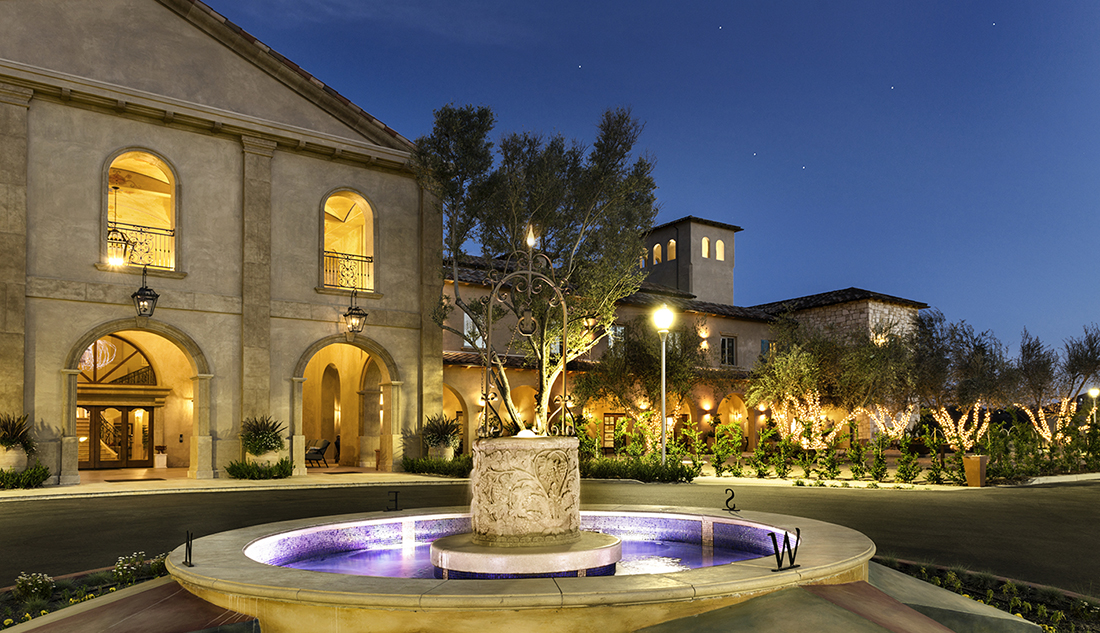 I’ll admit, I was nervous about traveling to California in the middle of one of its worst wildfire seasons on record. But my best friend was getting married in Paso Robles, one of the current trendiest wine country regions in the U.S., and I was eager to explore again after being trapped in the Lonestar State for nearly a year thanks to the pandemic. After studying the pattern of the wildfires, San Louis Obispo (SLO) County on the Central Coast was in an eerie eye of the hurricane in relation to the state’s rampant fires ravaging other wine regions.
I’ll admit, I was nervous about traveling to California in the middle of one of its worst wildfire seasons on record. But my best friend was getting married in Paso Robles, one of the current trendiest wine country regions in the U.S., and I was eager to explore again after being trapped in the Lonestar State for nearly a year thanks to the pandemic. After studying the pattern of the wildfires, San Louis Obispo (SLO) County on the Central Coast was in an eerie eye of the hurricane in relation to the state’s rampant fires ravaging other wine regions.
Paso Robles, the Spanish translation of Pass of the Oaks, is a charming historic town that has welcomed visitors since its roots as a mineral hot springs destination in the mid-1800s. Nestled into the foothills of the Saint Lucia Mountains halfway between San Francisco and Los Angeles, “Paso,” as locals call it, is 30 minutes inland from famous California beaches such as Morro Bay and Pismo Beach. The proximity to the ocean creates a coastal influence within the community, but its flourishing wine scene is clearly the pulse of the destination. With over 200 vineyards and 40,000 acres producing quality wine, Paso has captivated the elite wine industry and beyond.
Paso’s high-caliber grapes can largely be attributed to its fertile soil, drastic climate change and elevation variance that allow for a long growing season starting in April through November. In fact, the region has the greatest day to night temperature swing than any other wine appellation in California ranging from a high of 104 to a low of 55, according to Chris Taranto, a spokesperson for the Paso Robles Wine Country Alliance.
The area was originally known for zinfandel, which was introduced here in 1882. Nowadays, the region is heavy on cabernet at 38 percent of its volume and 16 percent of other reds, typically from Rhône-style grapes that do extremely well in Paso’s soil, according to the SLO County Agriculture Commissioner’s Office.
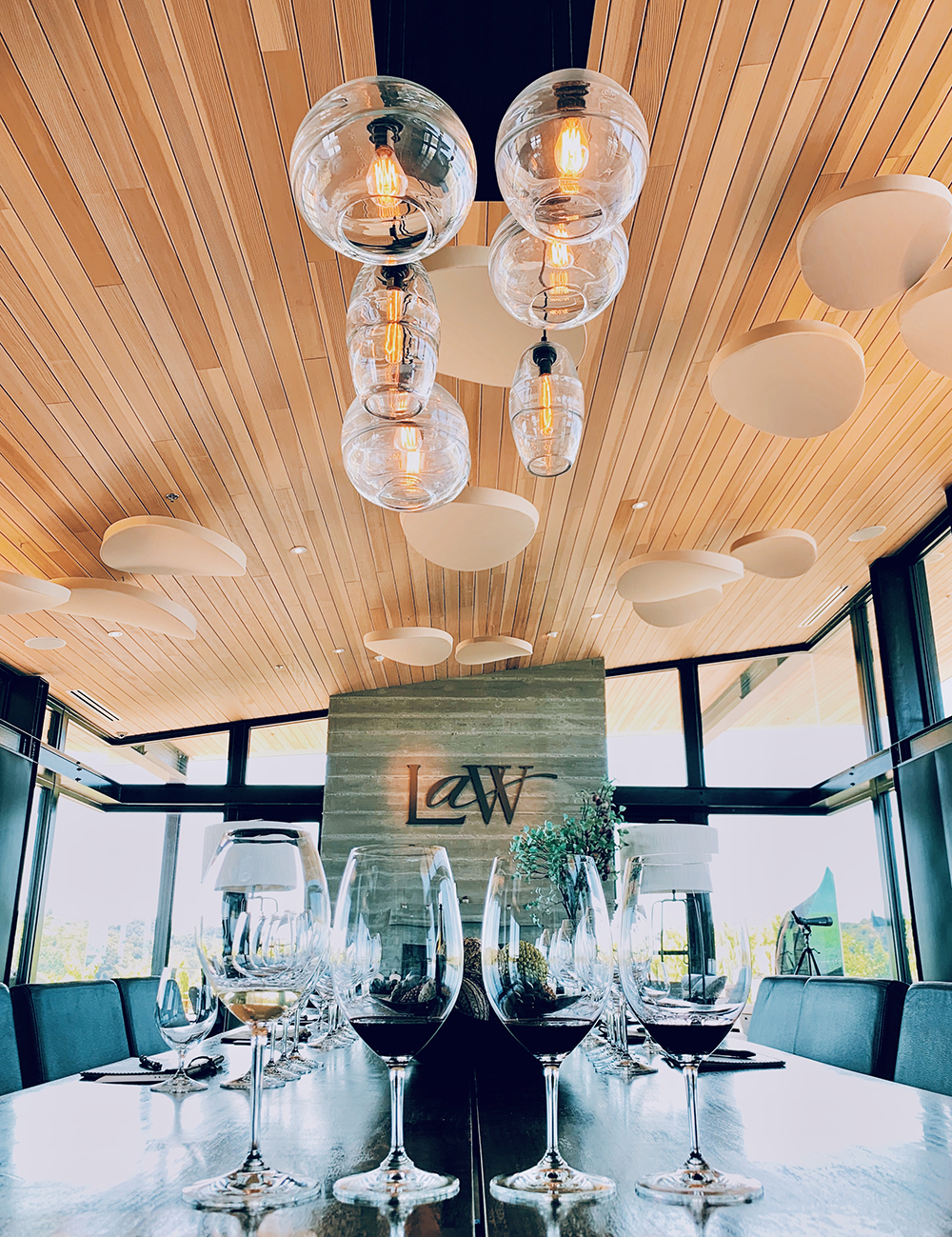 My Paso wine journey began in the Adelaida District at Adelaida Vineyards and Winery, which organically farms its wine on four vineyards that specialize in different French varieties. The winery’s Hoffman Mountain Ranch (HMR) is one of the most celebrated vineyards in California, as it was home to the first pinot noir vineyard on the Central Coast grown in 1964. Adelaida Vineyards was established in 1974 when Don and Elizabeth Van Steenwyk aquired HMR to add to their current vineyard portfolio.
My Paso wine journey began in the Adelaida District at Adelaida Vineyards and Winery, which organically farms its wine on four vineyards that specialize in different French varieties. The winery’s Hoffman Mountain Ranch (HMR) is one of the most celebrated vineyards in California, as it was home to the first pinot noir vineyard on the Central Coast grown in 1964. Adelaida Vineyards was established in 1974 when Don and Elizabeth Van Steenwyk aquired HMR to add to their current vineyard portfolio.
Adelaida’s tasting room is situated between its walnut orchards and vineyards and offers several tours and tasting experiences to meet the winemaking team and view the process in action. In addition to using French oak barrels and stainless-steel tanks to store and press its grapes, Adelaida also uses rare concrete tanks, producing a neutral taste that’s less industrial as stainless steel but not as flavor-enhancing as a wooden barrel. There is a Self Service Bar on site, which is fantastic and thoroughly enjoyable.
Guests who book a hilltop experience upon Adelaida’s Hilltop venue will sip limited-release wines at 2,320 feet – the highest peak in Paso – while taking in the striking natural beauty of the vineyards and mountains in the distance. The tasting is accompanied by a curated charcuterie board, complete with walnuts grown on the property. “Paso is a place that attracts winemakers who come to experiment from other areas where they might not have had that opportunity,” said Paul Sowerby, our Adelaida tour guide and a local expert. He explained that since Paso is a relatively new wine region, its rules are less traditional than appellations such as Napa Valley or even France and allows winemakers to have a bit more freedom in what they grow and blend.
From this experimentation came the “Paso” blend that was available at most wineries we visited, consisting of grenache, syrah and mourvèdre. Adelaida’s own winemaker, Jeremy Weinstraub, is a testament to this movement and migrated from Napa.
Taranto later elaborated on Sowerby’s observation, “Even the established winemakers are all about being ahead of the trend, finding that creativity and trying to craft really good wine,” he said.
I returned to the Adelaida District the following day to Law Estates in the valley of the steep slopes of Peach Canyon, a newer boutique winery opened in 2013 by Don and Suzie Law, with their original grapes planted in 2008. A geologist by trade, it took Don Law years to find his coveted limestone-based land with the best soil to create world-class wines. Law’s tasting room on the back porch opened up to picturesque vistas of the 80-acre vineyard. Everywhere you looked, you could see vines and the meandering canyon walls. The contemporary décor and furnishings of the winery was designed to evoke the comfort of a home living room while enjoying the estate’s wines.
We tasted a flight of blends of grenache and syrah, followed by cabernet and petit verdot with names to describe the punch and personality of each wine including Audacious, Beguiling, Aspire and Intrepid.
East of downtown Paso in the Estrella district is Eberle Winery, established by Gary Eberle who co-founded the Paso Robles Appellation in 1983. Eberle moved to town in 1973 from Pennsylvania and helped to create the largest winery in the area and first to grow Syrah, Estrella River Winery & Vineyards. Eberle later sold Estella and opened up a winery named after his family.
The vineyard’s winemaker, Chris Eberle (no relation to Gary) is a SLO native and began his career at Eberle. After honing his craft throughout the world in South Africa, Australia, New Zealand, Germany and France, Chris returned home to take his current post. He says that his German stint and experimentation there had the biggest influence on his current style.
Eberle’s tasting area is on a spacious outdoor patio overlooking hundreds of vineyard acres. The views go for miles and the sunsets are unobstructed. The signature group tasting includes a flight of five mixed Rhône-inspired reds and whites, and members and guests can book tours of the Eberle wine caves when available.
Near the northern boundaries of the Paso Region in a relatively isolated location in the Cholame Hills, Villa San-Juliette Vineyard and Winery is an idyllic chateau reminiscent of a European estate with dramatic Mediterranean architecture, fountains and lush landscaping. It was established in 2005 by Ken and Julie Warick and Nigel Lythgoe – the creators of the hit American Idol show.
Not all wineries in Paso are set up to host weddings and large events, but Villa San-Juliette Vineyard and Winery has mastered this concept as a venue with exceptional catering, event specialists and spectacular panoramas of the 130 acres of Rhône and Bordeaux-inspired grape vines. San-Juliette’s winemaker, Dan Smith, is an Oregon native and grew up inspired by the pinot noirs of Willamette Valley.
Where to Stay and Play
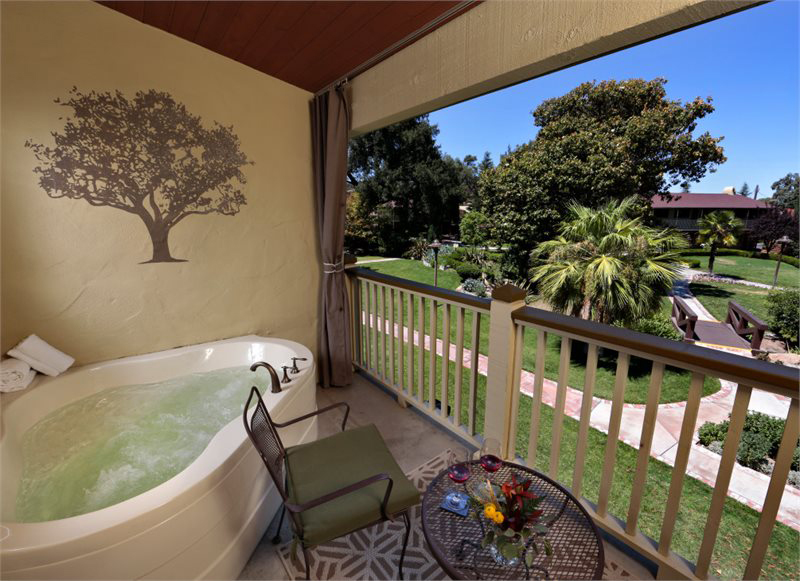 At Allegretto Vineyards and Resort, guests can enjoy wine tours on the property’s 20-acre vineyard, luxury accommodations and farm-to-fork gastronomy at Mediterranean-inspired restaurant Cello without ever leaving the grounds. Located just east of downtown, the 171-room resort is the vision of fourth-generation hotelier Douglas Ayres, who curated the brilliantly eclectic design and artifacts in the resort as his personal art gallery from his family’s global travels. Other unique amenities include a courtyard with firepits for entertaining on cool nights, horseback riding on the grounds and a first-of-its-kind Sonic Labyrinth, in which guests can benefit from a tranquil space with a distinctive series of wind instruments activated by motion sensors.
At Allegretto Vineyards and Resort, guests can enjoy wine tours on the property’s 20-acre vineyard, luxury accommodations and farm-to-fork gastronomy at Mediterranean-inspired restaurant Cello without ever leaving the grounds. Located just east of downtown, the 171-room resort is the vision of fourth-generation hotelier Douglas Ayres, who curated the brilliantly eclectic design and artifacts in the resort as his personal art gallery from his family’s global travels. Other unique amenities include a courtyard with firepits for entertaining on cool nights, horseback riding on the grounds and a first-of-its-kind Sonic Labyrinth, in which guests can benefit from a tranquil space with a distinctive series of wind instruments activated by motion sensors.
“Our resort is full of joy and discovery and creates the authentic feeling of being in Tuscany,” said Rich Verruni, general manager at Allegretto. “During a time when many people are not traveling to Europe, this is a great opportunity to visit a place with a heartbeat; it’s joyful and harmoniously inspired with intention.” Readers intrigued by the aforementioned mineral hot springs of Paso should consider a stay at the Paso Robles Inn, the only hotel that offers access to the springs via private soaking tubs in select balcony suites. In addition to its 98 guest rooms, the Inn also features a steakhouse, a nostalgic 1940s coffee shop, a cattleman’s bar lounge and meeting and event space.
“If you’re looking for the true heart of Paso Robles, you’ll find it at the Paso Robles Inn. Located right across from the tree-lined downtown square, the Inn sits right on the very spot where Paso Robles was founded over 150 years ago,” said Erica Fryburger, general manager at the Inn. “Established in 1889, the Paso Robles Inn is more than a landmark but a lasting legacy of the heartfelt hospitality that has made Paso such a special destination for over a century.”
The luxury resort and boutique hotel lodging scene in Paso is still growing. Smaller inns, bed and breakfasts and private residence vacation rentals are also popular among travelers. Another industry climbing to new heights in Paso is its golf.
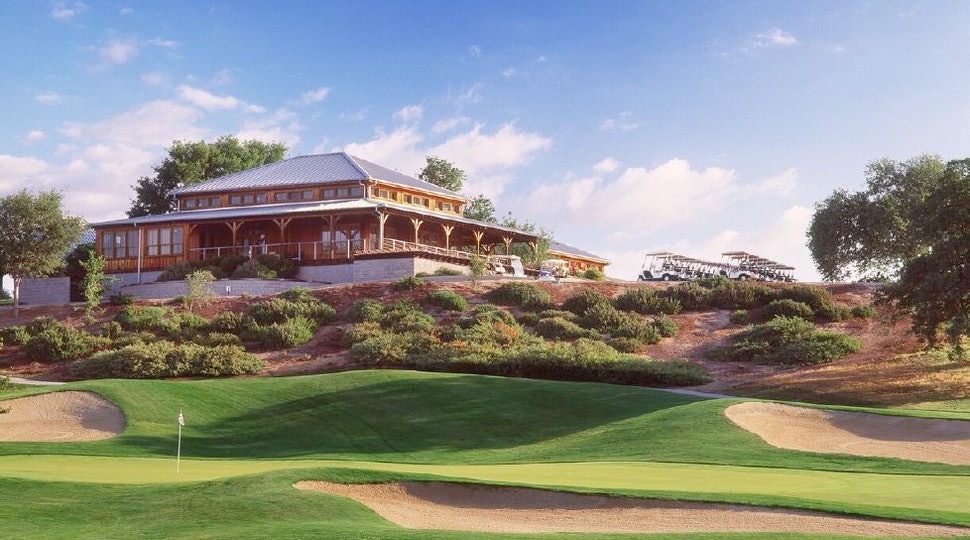 There are three golf courses that Paso locals recommend: Hunter Ranch Golf, Paso Robles Golf Club and Chalk Mountain Golf Course. Hunter Ranch is the crown jewel of the three, an 18-hole course designed in the tradition of classic courses such as Augusta National, Cypress Point and Pebble Beach. The well-manicured fairways provide views of mountain lakes and blue oaks and is thrilling for advanced and novice golfers alike.
There are three golf courses that Paso locals recommend: Hunter Ranch Golf, Paso Robles Golf Club and Chalk Mountain Golf Course. Hunter Ranch is the crown jewel of the three, an 18-hole course designed in the tradition of classic courses such as Augusta National, Cypress Point and Pebble Beach. The well-manicured fairways provide views of mountain lakes and blue oaks and is thrilling for advanced and novice golfers alike.
Set atop one of the highest points of Paso Robles, Hunter Ranch players can enjoy vistas of vineyards and wooded hills without any residential or commercial development in sight. The golf course also has a bar and grill serving breakfast and lunch for golfers and non-golfers to relax and enjoy breakfast fare, fresh salads and sandwiches. Hunter Ranch has a stay-and-play partnership with Allegretto and several other Paso hotels.
“Hole number 11 is a semi-highland green and our signature hole. It requires accuracy off the tee and then again coming into the green,” said Steve Hahn, director of golf.
Paso Robles Golf Club is under new ownership and has stepped up its game in recent years. The 18-hole, par 70 course and clubhouse just underwent a complete renovation. The Paso Robles Golf Club hosts myriad tournaments each year for adults and juniors, and they also offer golf lessons and event space for weddings and special occasions. The community-oriented club is home to Deeds Bar & Grill, serving up breakfast options, fresh greens, seafood dishes in a sleek dining room.
The third recommended course, Chalk Mountain, is about 15-20 minutes south of Paso in Atascadero on the way to the coast. Known to locals as “challenging, yet funky and unique,” this Robert Muir Graves-designed championship course has large greens for beginners while they’re daring enough to beckon experienced golfers to press their luck. Chalk Mountain also has stay-in-play deals with SLO hotels closer to Morro Bay on the coast, as well as its SLO County Golf pro shop serving the region for golf gear and attire.
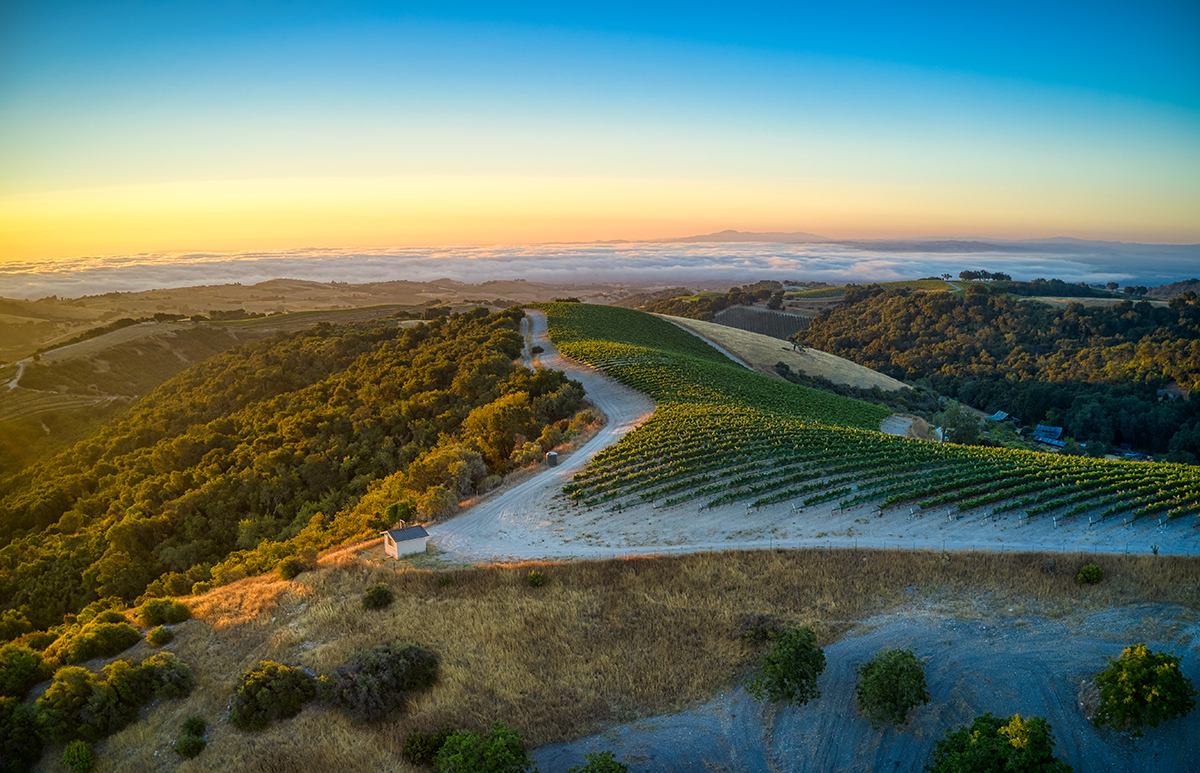 The Town
The Town
As I strolled through the Paso Robles Downtown City Park, the square felt similar to the atmosphere in the central Marketplatz in Fredericksburg, Texas, only with more of a relaxed California vibe instead of palpable German heritage. You won’t find many national chain restaurants or shops here, but an assortment of upscale small and regional businesses. According to Taranto, the budding town of thirty thousand has a fierce sense of community among native and transplant entrepreneurs looking to contribute to its “shop small” sustainability efforts.
“The majority of our business owners have taken that step to not only be a part of a community, but truly invest in it and hope that Paso will invest in them,” said Taranto.
Chef-led restaurants, craft breweries and distilleries are increasingly popular in Paso. The locally-made beer and spirits are overshadowed by the wine but are underrated and deserving of attention. Bars that tend to have beer tap systems filled with a locally made drink earlier, now seem to be replaced with wine. Among the restaurants I found most enticing was Hatch Rotisserie, started by two local winemakers. As the name suggests, this poultry-forward eatery serves up family-style plates of southern comfort food and local produce. Try the mushroom appetizer generous enough for a meal or ask to include some SLO-grown avocado with your salad.
Next on the list is La Corsecha Bar + Restaurant, which features Latin and Spanish fare complemented by creative mixology and an engaging ambiance. Spanish for “the Harvest,” La Corsecha is the second restaurant in Paso opened by Honduran Executive Chef Santos MacDonal, who made a name for himself in Los Angeles prior to moving to the Central Coast. Locals recommend the spicy Brazilian soup.
Lastly, for brunch or a morning perk, Amstrdm Coffee House and Piano Lounge won’t disappoint. Amstrdm features breakfast burritos, decadent baked goods and third-wave coffee in an acoustically treated dining room with live piano jazz that pours out into the streets of Paso. On weekend evenings, the hipster coffee lounge transforms into a sophisticated wine bar.
To cleanse the palette after a day of wine tasting, there are several watering holes to grab a craft beer. Backyard on 13th is a casual, family-friendly establishment where guests can unwind by the fire pits in the outdoor biergarten with a quick, gourmet meal from its culinary partner, Roots on Railroad. Craft beer lovers can take advantage of the bourgeoning brew scene at breweries such as Barrelhouse Brewing Co., California Coast Beer Co., and Firestone Walker Brewing Co.
By Katie Soltas